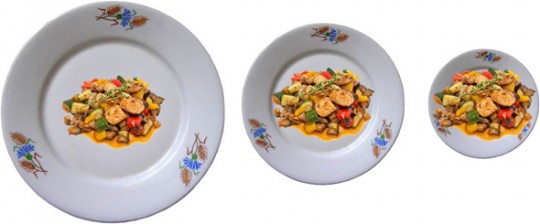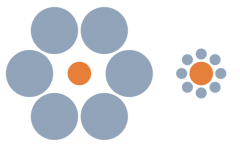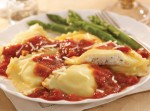Chef’s Secret: How to Make Your Product Look Bigger

Some restaurants want to make their portions look bigger. Others may want to seem to deliver a modest portion while still satisfying hungry diners. For years, chefs have exploited what’s known as the Ebbinghaus illusion to push the apparent portion size in one direction or the other. Serve a dish on a small plate, and it looks bigger. Put the same food in the middle of a much larger plate, and the portion seems smaller. But, this illusion isn’t just for eateries – marketers of all kinds can exploit what’s known as the Ebbinghaus illusion.
 The Ebbinghaus illusion makes a circle surrounded by other circles seem smaller when the surrounding circles are farther away. In the dinner plate example, the same portion of food looks bigger when it almost touches the edge of the surrounding plate edge, and smaller when it is in the middle of a larger plate. A classic example of the Ebbinghaus illusion surrounds a circular shape with circles of different sizes. You may think your eyes are fooling you, but the two orange circles in the illustration are the same size.
The Ebbinghaus illusion makes a circle surrounded by other circles seem smaller when the surrounding circles are farther away. In the dinner plate example, the same portion of food looks bigger when it almost touches the edge of the surrounding plate edge, and smaller when it is in the middle of a larger plate. A classic example of the Ebbinghaus illusion surrounds a circular shape with circles of different sizes. You may think your eyes are fooling you, but the two orange circles in the illustration are the same size.
For years, dieters have been advised to use a smaller plate to lower their calorie intake. Beyond the obvious advantage of limiting the dieter’s ability to pile more food on, the small plate may also trick the brain into thinking the portion is actually larger and more satisfying.
Product Presentation
This illlusion can be helpful in emphasizing the characteristics of your product in advertising or in physical displays. In particular, if a key advantage of a product is its compact size, emphasize that characteristic by surrounding it with white space bordered by a ring of some kind. Conversely, when bigger is better, surrounding your product with smaller shapes or a tight circle will emphasize its size.
 Diet company Nutrisystem provides its customers with food items designed to limit calories while seeming sumptuous. Their food photographers have learned how to make their small portions look large, in part by using dishes that barely contain the product.
Diet company Nutrisystem provides its customers with food items designed to limit calories while seeming sumptuous. Their food photographers have learned how to make their small portions look large, in part by using dishes that barely contain the product.
But, the illusion doesn’t just work for food – have you run across an example of a product make to look bigger or smaller in this way? Post a comment to share.
[Portion illusion photo credit: Mighty Optical Illusions]
